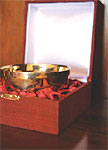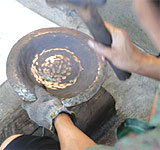 As I am walking into a small pathway, beside me is a halfburnt
house that vividly brought to my mind the sound
of a roaring fire. It was easy to imagine the scene as I
tried to walk through a tiny street that leads to a place that was
once known as the home of a skillful community called Ban Bu.
It is such a shame that the community burned down not long
ago in a terrible accident, but there is a long history behind the
wrecked buildings.
Ban Bu Village is situated on the bank of Bangkok Noi canal.
The villagers are descendants of migrants who fled Ayutthaya
when Burmese troops razed the old capital. The village is
famous for its stone-washed metal bowls, called khan long hin.
It is a community renowned for its metal workers, who fashion
exquisite bronze bowls using traditional methods.
These khan long hin can be found throughout the narrow lanes
of the neighborhood with the best-known workshop, that of
the famous metal worker Jiam Sangsajja. The factory is run
by a member of the second generation, Mrs. Metta Salanon
(Sangsajja), who welcomes all visitors and takes them on a
tour through the historical path of khan long hin Ban Bu. She
explains, “khan long hin, or stone-polished bronze ware, which
is an old Thai handicraft product that goes back more than 200
years, is bronze ware polished with small pieces of stone. Ban
Bu is the only village presently making khan long hin in the old
method. The villagers had originally migrated from Krung Si
Ayutthaya after the fall of the Ayutthaya kingdom, and they
have made bronze products here since AD 1767.”
As I am walking into a small pathway, beside me is a halfburnt
house that vividly brought to my mind the sound
of a roaring fire. It was easy to imagine the scene as I
tried to walk through a tiny street that leads to a place that was
once known as the home of a skillful community called Ban Bu.
It is such a shame that the community burned down not long
ago in a terrible accident, but there is a long history behind the
wrecked buildings.
Ban Bu Village is situated on the bank of Bangkok Noi canal.
The villagers are descendants of migrants who fled Ayutthaya
when Burmese troops razed the old capital. The village is
famous for its stone-washed metal bowls, called khan long hin.
It is a community renowned for its metal workers, who fashion
exquisite bronze bowls using traditional methods.
These khan long hin can be found throughout the narrow lanes
of the neighborhood with the best-known workshop, that of
the famous metal worker Jiam Sangsajja. The factory is run
by a member of the second generation, Mrs. Metta Salanon
(Sangsajja), who welcomes all visitors and takes them on a
tour through the historical path of khan long hin Ban Bu. She
explains, “khan long hin, or stone-polished bronze ware, which
is an old Thai handicraft product that goes back more than 200
years, is bronze ware polished with small pieces of stone. Ban
Bu is the only village presently making khan long hin in the old
method. The villagers had originally migrated from Krung Si
Ayutthaya after the fall of the Ayutthaya kingdom, and they
have made bronze products here since AD 1767.”
|
 Bronze is an alloy of metals, a combination of tin, copper, and
a special type of gold called thong ma lo. For a long time, Thai
people have used bronze products such as deep bowls and
shallow bowls. Traditionally, these bronze pieces were used in
the performance of religious ceremonies; often people would
float flowers in them to give the water a pleasant aroma. They
would also be used to hold rice to be donated to monks, again
with flowers inside, as the flowers would impart a fragrance to the
rice. The most highly regarded khan is the stone-finished type.
Despite there being seven meticulous steps in the production
process, there is no assistance from modern technology. The
bowls are made by hand from start to finish: molding and shaping
the bowl and carving the elaborate Thai designs.
Bronze is an alloy of metals, a combination of tin, copper, and
a special type of gold called thong ma lo. For a long time, Thai
people have used bronze products such as deep bowls and
shallow bowls. Traditionally, these bronze pieces were used in
the performance of religious ceremonies; often people would
float flowers in them to give the water a pleasant aroma. They
would also be used to hold rice to be donated to monks, again
with flowers inside, as the flowers would impart a fragrance to the
rice. The most highly regarded khan is the stone-finished type.
Despite there being seven meticulous steps in the production
process, there is no assistance from modern technology. The
bowls are made by hand from start to finish: molding and shaping
the bowl and carving the elaborate Thai designs.
|
 “Bu” is a word that means metal beating. It is a method for
decorating the surface of works of art, durable goods, and certain
kinds of architecture, to enhance their value and endurance.
The term “metal beating” means to wrap the object with a thin
material or to beat something into shape, such as bu khan long hin
(beating bronze on a bowl using a stone mold for the pattern).
Metal beating has been a royal craft since the old days. Metal is
beaten into thin sheets and wrapped over a model, which can be
made of various materials such as wood, plaster, or metal. Metal
beating can be applied to small objects as well as huge ones. In
the making of a bowl, the three molten metals are combined in a
single mould and fired again. The resulting alloy is hammered into
shape and turned on a lathe. In the past, fine crushed stone and
water wrapped in a cloth were used to polish the surface of the
khan. Today this is done by crushing the molds after casting. As
they have been in the fire during the casting process, they make
a good polishing medium. Stone-finished khan are still used for
their original purposes, but are now mostly in demand as house
decorations, and they are a favorite gift for foreign visitors. The
bowls are available in many sizes for various occasions. There are
deep bowls, salad and fruit bowls, trays, cream and sugar bowl
sets with an oval tray, and shallow bowls without a base.
“Bu” is a word that means metal beating. It is a method for
decorating the surface of works of art, durable goods, and certain
kinds of architecture, to enhance their value and endurance.
The term “metal beating” means to wrap the object with a thin
material or to beat something into shape, such as bu khan long hin
(beating bronze on a bowl using a stone mold for the pattern).
Metal beating has been a royal craft since the old days. Metal is
beaten into thin sheets and wrapped over a model, which can be
made of various materials such as wood, plaster, or metal. Metal
beating can be applied to small objects as well as huge ones. In
the making of a bowl, the three molten metals are combined in a
single mould and fired again. The resulting alloy is hammered into
shape and turned on a lathe. In the past, fine crushed stone and
water wrapped in a cloth were used to polish the surface of the
khan. Today this is done by crushing the molds after casting. As
they have been in the fire during the casting process, they make
a good polishing medium. Stone-finished khan are still used for
their original purposes, but are now mostly in demand as house
decorations, and they are a favorite gift for foreign visitors. The
bowls are available in many sizes for various occasions. There are
deep bowls, salad and fruit bowls, trays, cream and sugar bowl
sets with an oval tray, and shallow bowls without a base.
|
 Mrs. Metta adds, “We became well known after we received
many awards from the One Tambon, One Product (OTOP)
Project, and that helped us attract more customers, which
is really helping in terms of expanding our market and
knowing our customers. They really help with the ideas and
functional designs – as you can see, there are many pieces with designs
that I have adapted for uses in daily life. About 50 years ago, the bronze
products had been developed into many different kinds beside deep
bowls and shallow bowls. Plates, salad bowls, fruit bowls, ash trays,
foods trays, for example, these are popular among foreigners, so these
bronze products have become export items. However, the methods of
production still follow the old ways, whether it’s melting the raw materials
or using the hammer to shape them up.”
Mrs. Metta adds, “We became well known after we received
many awards from the One Tambon, One Product (OTOP)
Project, and that helped us attract more customers, which
is really helping in terms of expanding our market and
knowing our customers. They really help with the ideas and
functional designs – as you can see, there are many pieces with designs
that I have adapted for uses in daily life. About 50 years ago, the bronze
products had been developed into many different kinds beside deep
bowls and shallow bowls. Plates, salad bowls, fruit bowls, ash trays,
foods trays, for example, these are popular among foreigners, so these
bronze products have become export items. However, the methods of
production still follow the old ways, whether it’s melting the raw materials
or using the hammer to shape them up.”
|
It is a source of pride for Mrs. Metta’s family to be a representative of
the art of making khan long hin. While she was taking me on the tour,
she explained, “We have only 12 workers and they have been with us
as long as I can remember. It is such a shame that this might be the last
generation, and they are getting old. Most of their children want to do
easier jobs. Working in front of a fire would not be their first choice.” She
told me, as she pointed out an empty lot, “As you can see here, we are
constructing a building that we will use in the near future as a museum of
Ban Bu and showcase our products. We hope that this will attract tourists
as well as Thai people, and they will know that Ban Bu exists and has
retained its identity as a community that presents the best in Thai crafts.”
Ban Bu Community
Charansanitwong Road, Soi 32
Siriraj Subdistrict
Bangkok Noi District
Bangkok 10700
Open daily 9 a.m. - 6 p.m.
Free admission
Call (66) 0 2424 1689
(66) 0 2424 7493
|
|
|








